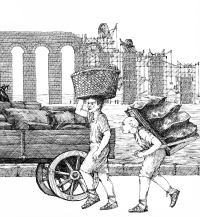


Labour
Historians are not sure how major public projects were completed in Rome (Flower, 2004:174). Chanson (1999) and Hodge (2002:191) states that the majority of the labour was undertaken by the army; however, private and public slaves and forced labour also played its part in the construction of roads, harbours and other public buildings (Flower, 2004:174).There is also some direct evidence, from the Roman colony of Puteoli, of public contracting with citizens. The lex parieti faciundo is a detailed document from 105 BC drafted by local duumviri that describes the job of building a wall. Potential contractors, known as redemptores, were required to provide sureties in the form of people, known as praedes, and landed property, or praedia. The 'redemptores' had to respect set dimensions and quality standards in terms of the construction materials they employed. The work was to be completed to the satisfaction of the duumviri and a council attended by at least twenty former duumviri. Payment was made in two instalments, half at the time of contracting and half at the time of approval (Flower, 2004:174).
A great deal of Roman building construction was based on the principle of mass production by semi-skilled labour. This would have lent itself to modular design, the repeated construction of identical elements, such as arches and columns (Hodge, 2000:164). This simplified the Roman building process, and allowed the system to perpetuate itself without extensive education of the labourers and administrators. It also had the beneficial consequence of providing work for a large number of people, who may otherwise have turned their attentions to antisocial behaviour.
As Roman labour was probably relatively unproductive on the average (Hodge, 2002:128), the cost of building aqueducts may have been more expensive than they should have been. However, this may not have been a serious issue. The construction of the aqueducts would have increased the food supply in the areas surrounding them by providing more water for irrigation. However, it is not certain if aqueduct water was used for farm irrigation in Rome, though it is likely that it was, even if not officially. Increased drinking water would have increased productivity anyway. The majority of the labourers would have been in the field with a ready supply of water. Keeping so many occupied in construction for so long and then having so many enjoy the fruits of the labour in the form of increased production of food, potable water and entertainment, will have outweighed the inefficiencies in the system. There is some evidence that Vespasian, at least, recognised the political necessity of keeping people occupied. In his Life of Vespasian, Suetonius writes (18):
To an engineer who promised to transport some heavy columns to the Capitoline Hill at a low cost, he gave a significant reward for his scheme, but refused to put it into operation, saying "You must let me feed the poor folk".
From the thesis of Evan J. Dembskey on The aqueducts of Ancient Rome